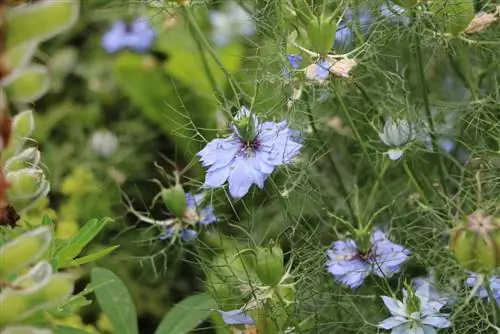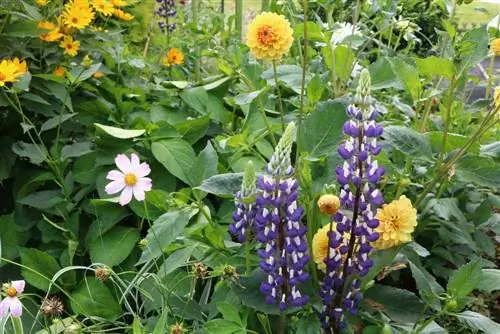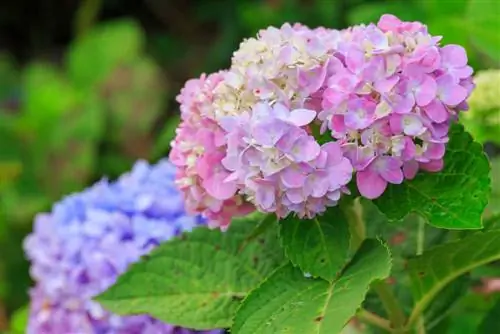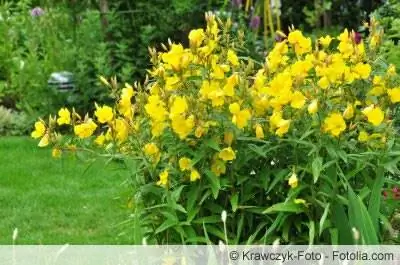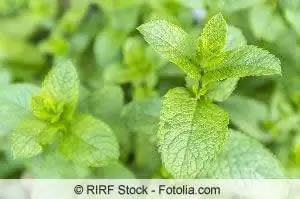- Author admin [email protected].
- Public 2023-12-17 03:39.
- Last modified 2025-01-24 12:45.
The maiden in the green, originally from the Mediterranean region, was at home in almost every garden in earlier times. The versatile ornamental plant with impressive flowers is an annual summer bloomer. You only need to know a little about the needs of Nigella damascena in order to successfully cultivate it in your own garden.
The plant with the characteristic bracts, which are arranged in a spider web-like structure around the flower crown, is rarely found in home gardens. The maiden in the countryside used to be a must in every farm garden. Nigella damascena is extremely robust; even snails avoid the annual summer flower. Whether it's a natural garden or a self-catering paradise: the buttercup plant can cope with even smaller areas. Even with planters, the ornamental flower is satisfied with the impressive flowers.
Location and soil
Even around the turn of the last century, the maiden in the green was one of the most popular cottage garden plants. Even today, the annual summer bloomer gives natural gardens an old-fashioned charm. The flowers, which belong to the buttercup family, require a sunny to partially shaded location. If the place is too shady, the flowers will visibly suffer, which is why you should avoid these places. Depending on the variety, the virgins can reach a height of between 20 and 70 centimeters. This creates interesting possibilities for combining the different types of Nigella damascena.
The fast-growing cottage garden plant is extremely robust and thrives almost anywhere in the garden. Even a dry or poor substrate is tolerated by the maiden in the green. However, to promote he alth and flowering, the soil should ideally be deep and rich in humus. In the planter it is sufficient to enrich conventional potting soil with humus.
Watering and fertilizing
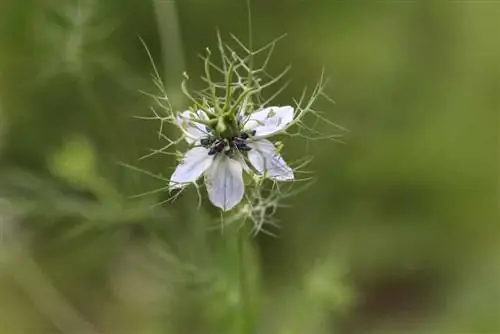
“Gretchen in the bush” and “Damascus caraway,” as the maiden in the green is also often called, is one of the undemanding inhabitants of a garden. The plants can also survive longer dry phases in summer. However, the heat wave often does not leave the plants unscathed unless countermeasures are taken beforehand. Water the plants regularly. Nigella damascena doesn't really care whether you use rainwater or calcareous tap water. The ornamental plants only accept standing moisture temporarily. Counteract waterlogging and the associated root rot in advance. The other plants in your garden will also benefit if you loosen the soil in the beds with fine pebbles. This counteracts compaction of the substrate so that water and air can reach the roots better.
Long-term or liquid fertilizer from specialist retailers does not have to be used on the annual and herbaceous ornamental plant. You can meet the nutrient requirements of the black cumin family by mixing the soil with compost in spring and late summer. Mulch the soil regularly while removing any annoying weeds. You can feed the summer bloomers in planters about every 4 to 6 weeks with conventional liquid fertilizer.
Plants
Nigella damascena is propagated exclusively by sowing. If the plant feels comfortable in the selected location, it actively contributes to its reproduction. In some circumstances, you may even have to restrict the youngster's strong urge to spread in the countryside. This is done by continually removing the wilted flowers. In order to cultivate the plant, which is originally native to the Mediterranean region, in your own garden, only a little effort is required. Sowing takes place directly in the bed from March. Late frosts have little effect on the Gretchen in the bush, so you can avoid growing it in a planter beforehand.
The buttercup plant is one of the dark germinators; the first shoot tips appear after a maximum of 20 days. However, ambient temperatures around 17°C can accelerate germination.
Prepare the bed before sowing:
- Remove the soil from root residues, weeds and stones.
- Mix substrate with humus.
- Sowing seeds.
- Cover the seeds with soil.
- Keep evenly moist.
Tip:
It is best to mark the spot where you planted the seeds. Germinating ornamental plants can all too easily be confused with unwanted weeds.
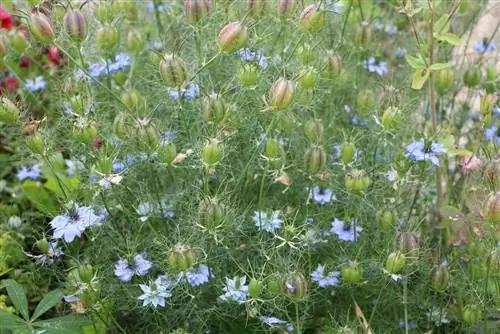
The maiden in the green is also suitable for planting in containers. For example, you can transform your large balcony or sunny terrace into a Mediterranean landscape. Whether in the garden or in the pot, combine the plants with other summer bloomers, such as delphiniums, daisies, lilies and dahlias. Nigella damascena only comes into its own in company. Planters can be prepared as follows:
- Choose a sufficiently large bucket.
- A drainage made of porous material is created at the bottom.
- Enrich the substrate with humus.
- Fill the container with the prepared soil.
- Sowing seeds.
- Moisten the soil regularly.
Place the bucket in its final location outdoors before the ornamental flowers germinate. The cottage garden plants are extremely robust and can easily withstand direct sunlight even as young plants.
Propagate
Harvest the plant's seeds before they are thrown out of their shell by the wind. Seed ripening begins around August. As soon as the seed capsule turns brown, the seeds inside are ripe and can be collected. To prevent uncontrolled sowing, you should work quickly. On hot and sunny days, the capsules open and the seeds spread themselves over a large area in the garden. Seeds that are still immature should be left to ripen in a dry place.
Cutting
Classic pruning or shaping is not done for summer bloomers that are only cultivated as annuals. Removing wilted inflorescences will in no way encourage the plant to produce a second bloom. However, by cutting spent parts of the plant, you can stop the ornamental plants' strong urge to multiply. If you have missed the right time and the seeds have already ripened, remove the plant parts using a glass. If you put this over the seed capsule from below, the seeds that fall out cannot reach the ground. You can still prepare the bed or flower pot for the maidens in autumn. For sowing in spring, the seeds must be stored in a dry, cool place.
The maiden in the green is also suitable as a vase decoration. The decorative flower decorations are cut shortly before the flowers open. Use a sharp knife for this, as the cutting mechanism of scissors only crushes the stems unnecessarily. Nigella damascena creates an extremely effective appearance in the vase even when dried. The dried seed capsules decorate every bouquet of dried flowers. To do this, the maiden in the green is cut before the seed casings open. Whether you cut the plant close to the ground or only use the top 15 centimeters is entirely up to you. Place the plant upright in a container without water; the drying location must not be exposed to direct sunlight. With fine powder silica gel you can preserve the colors of the ornamental flowers to some extent.
Wintering
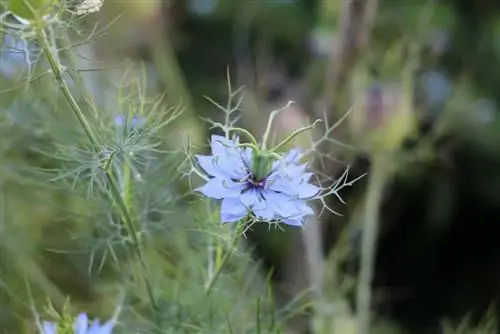
The plant, which originally comes from the Mediterranean region, is an annual, and you can do without special winter protection. Flower ripening begins immediately after the last flowering. If you have no objection to self-sowing, the wilted shoots are not removed until spring. However, if you want to control the maiden's urge to reproduce in the countryside, cut off the withered flowers or the entire plant before the seeds ripen. In regions with mild winters, it is not unusual for young Nigella to survive the cold season unscathed.
Conclusion
The buttercup plant is an extremely fascinating and robust plant. Even if you only have a small amount of time to invest in your garden, you can easily grow and cultivate damselfly in the countryside. The plant can be easily planted together with other summer bloomers. Only heavy self-seeding can quickly become a problem in smaller ornamental gardens. If this is undesirable, you should remove the wilted flowers before the seeds ripen.

